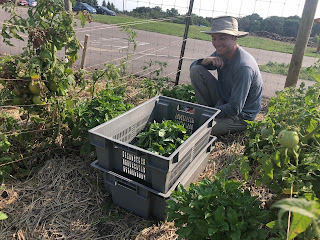Annalisa Hultberg - Extension Educator - food safety
If your farm or garden is able to donate excess or dedicated produce to food shelves, churches or other hunger relief efforts this summer and fall, you are helping your fellow citizens find access to fresh and healthy locally grown food.
Remember some basic food safety considerations when you are donating or selling produce to others. Not all consumers are the same - if the consumer of your food is pregnant, a child, elderly or has cancer or other underlying condition and therefore a weakened immune system, they are more susceptible to more serious complications from food borne illnesses that might cause only nausea or diarrhea in healthy people. We have no way to know all of the eaters of our food- that's why a little prevention is very important.
The goal of food safety practices when growing fruits and vegetables is to prevent contamination of the produce with harmful bacteria and viruses that can make people sick. Pathogenic E. coli, Salmonella, and Listeria monocytogenes are some of the most common bacteria that can sicken consumers via fresh produce.
Here are some tips for food safety when donating produce to reduce food safety risk when harvesting, packaging and transporting fresh produce for others.
During Harvest
- Harvest into clean containers, like dedicated totes, that are free from visible soil. Don't use an old bag or other non food-grade packaging. Don't use a container that had treated seeds, chemicals or other materials that could leach into the plastic.
- Don't harvest when you are sick - if you have symptoms of illness like nausea, diarrhea or vomiting, or those associated with COVID-19, do not harvest or touch produce for others.
- Wash your hands before you harvest, every time, using soap and water. The water does not need to be hot. This is the number one thing you can do to prevent the spread of unwanted contamination to your produce. If your house is a far distance from the field, consider having a portable hand washing stand or carry a hand washing kit in your vehicle. See instructions for building a handwashing stand here.
- Look for signs of animals like scat, fur, and nibbled produce, and do not harvest the produce that is close to these signs. Animal waste has been implicated in many foodborne illness outbreaks, so make sure you don't harvest any produce with might have fecal material on it.
After Harvest
- Storage temperature: Keep produce cool during storage and transport. Different produce should be kept at different temperatures, depending on the commodity. This UMN Extension website has useful information about proper storage temperature and relative humidity for various crops. While the title is targeted to gardeners, it actually has useful information for farmers at all scales. If you will store the product on the farm, make sure it is stored in a clean, pest-free environment.
- Washing: Not all produce needs to be washed on the farm. The washing process can actually reduce the storage life of some products, and can spread contamination via water if it is present on the outside of the product. Label the product as "unwashed" when delivering if you don't wash it. The consumer should always wash all fresh produce before consumption, regardless of if you wash it or not.
- Not washed: Berries, herbs, storage onions, tomatoes and some other storage crops are generally not washed on farm.
- Wash with care: Some products like greens, melons, cucumbers, zucchini, peppers, eggplant, green beans might also not need to be washed, depending on how they were grown, recent rainfall etc. Check with the location that will take the produce you are donating, and ask about if you need to wash these, and err on the side of not washing if possible.
- Generally wash: Most root vegetables will need to be washed to remove the bulk of the soil before donation to remove sand and soil. Use a clean washing tank or container, clean water and clean hands when washing. Many farms use an approved wash water sanitizer in the wash water to reduce the potential for cross contamination in a bulk wash tank. Or, use a spray table to give the roots a "shower", not a bath.
- Packaging: Whatever you will be putting your fruits and vegetables in to transport them, make sure that it will not become a source of contamination to your produce. Use new, single-use or clean boxes or bags whenever possible. If you re-use boxes, make sure they are in good shape, or consider using a plastic liner to reduce the potential for contamination.
- Transport: Transport the produce in a clean vehicle that does not have garbage, chemicals or pet hair in it that could be a source of contamination. Remember temperature is very important for product quality and food safety. Keep the produce as cool as possible from your farm to the final destination.





Comments
Post a Comment